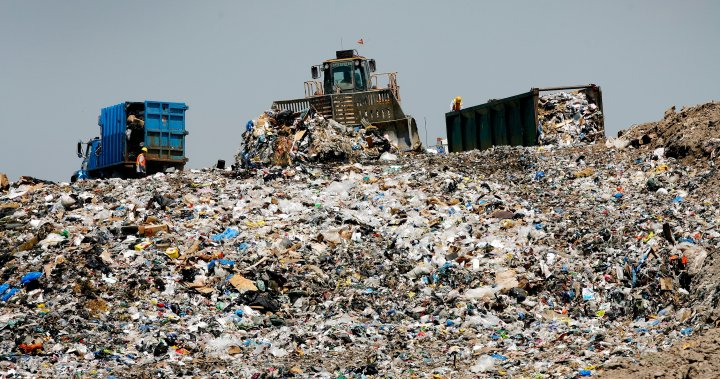Breaking News
Toronto’s ability to handle landfill garbage nearing capacity, city warns

The City of Toronto is warning its ability to handle garbage at its landfill is nearing capacity.
It says the Green Lane Landfill, which the city has owned since 2007, will not be able to keep up with the amount of waste the city’s growing population is producing.
Staff are warning the city it needs an updated long-term waste strategy, and they’re turning to the public through a series of consultations for help on it.
“The timing of these public consultations is important as the city’s-owned Green Lane Landfill, a state-of-the-art facility that manages the majority of Toronto’s garbage, will approach capacity in 2035,” the city said in a November news release.
“Last year alone, the city managed close to 830,000 tonnes of waste. It is critical to start planning now, as planning, regulatory approvals and construction of new waste disposal infrastructure can take more than 10 years.”
City has tried to extend landfill’s lifespan
The city last updated its long-term waste management strategy in 2016, and was warned then its landfill, which is located near St. Thomas, Ont., was reaching the end of its lifespan.
That lifespan, the city says on its website, is dependent on the rate that waste is sent for disposal. The less waste produced, the less there is to manage. However, a rising population and steady waste production levels means Green Lane will not be a viable option for much longer.
The city has tried to extend the landfill’s lifespan, staff said in a May 2023 report. Staff said to date, they have renegotiated the contract with the landfill’s operator to send less waste there without incurring additional fees.
Peter Power/The Globe and Mail via The Canadian Press
Staff have also renegotiated waste compaction requirements at the site, and have negotiated extensions to alternate landfill disposal contracts that allow for redirection of a portion of the City’s waste to other Ontario landfills.
However, those actions are only able to help in the near term, staff said in the report.

Get breaking National news
For news impacting Canada and around the world, sign up for breaking news alerts delivered directly to you when they happen.
“The urgency to secure and/or establish long-term disposal capacity is increasing as the City’s only operational landfill, Green Lane Landfill, has a limited remaining lifespan,” the report reads.
“Existing landfill capacity in Ontario is also limited and recent regulatory changes by the Government of Ontario have added additional complexity for establishing new landfills.”
Issue won’t be unique to Toronto, staff say
Given the city doesn’t have enough land within its borders to build a large landfill – which staff say would take years to do – competition to find a site will be fierce.
In that report, staff cited a provincial study done in 2021 that found by 2034, there will be no remaining landfill capacity in Ontario. The study found municipalities are beginning to utilize private landfills, which as of 2020 made up 53 per cent of active landfills in the province.

It also said Ontario’s remaining landfill capacity is even more vulnerable as roughly 30 per cent of the province’s waste is exported to Michigan, New York State or Ohio.
Unforeseen border closures, or increases in waste disposal fees in the United States, could result in more waste requiring disposal within the province. Also, if Ontario waste were to no longer be exported to the United States, the province’s landfill capacity could be depleted even sooner.
Furthermore, staff said new regulations introduced by the province in 2020 restrict new landfill development, as any builder interested in construction at a site must get approval by both the host city and municipalities that have residential land within 3.5 kilometres of a proposed landfill site.
Peter Power/The Globe and Mail via The Canadian Press
“This requirement effectively gives each local and adjacent municipality ‘veto’ power over the development of the landfill,” staff said in May 2023, adding it requested clarification from the province in 2021 and never heard back.
“As the city, along with other Ontario municipalities share the same challenges in securing long-term residual waste management capacity, it is anticipated that the waste landscape in Ontario will become more scarce, competitive and costly as landfill capacity diminishes.”
Public drop-in event happening Tuesday
The first phase of the city’s consultations on the long-term waste strategy will focus on gathering feedback on the vision and guiding principles of the plan.
It has launched an online survey that is open until Dec. 20, and is hosting a public drop-in event at St. Paul’s Bloor Street on Tuesday from 2 to 8 p.m. Eastern.
The city will also host two virtual public consultations on Thursday from 2 to 3:30 p.m., and Dec. 11 from 7 to 8:30 p.m.
© 2024 Global News, a division of Corus Entertainment Inc.
-

 Destination6 months ago
Destination6 months agoSingapore Airlines CEO set to join board of Air India, BA News, BA
-

 Breaking News8 months ago
Breaking News8 months agoCroatia to reintroduce compulsory military draft as regional tensions soar
-

 Tech News10 months ago
Tech News10 months agoBangladeshi police agents accused of selling citizens’ personal information on Telegram
-

 Breaking News8 months ago
Breaking News8 months agoBangladesh crisis: Refaat Ahmed sworn in as Bangladesh’s new chief justice
-

 Gaming7 months ago
Gaming7 months agoThe Criterion Collection announces November 2024 releases, Seven Samurai 4K and more
-

 Toys10 months ago
Toys10 months ago15 of the Best Trike & Tricycles Mums Recommend
-

 Toys8 months ago
Toys8 months ago15 Best Magnetic Tile Race Tracks for Kids!
-

 Guides & Tips8 months ago
Guides & Tips8 months agoHave Unlimited Korean Food at MANY Unlimited Topokki!


























